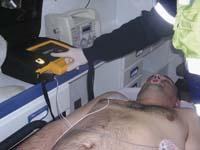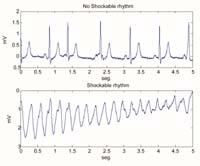Cardiac resuscitation algorithms

This was the starting point of researchers from the Department of Electronics and Telecommunications of the School of Engineering of Bilbao, the development of algorithms of these tools designed for adults. At present, we are working on the development of reliable algorithms suitable for children and overcoming this narrow time limit.
AED Child
The use of automatic defibrillators for adults is widely extended. However, the cardiac rhythms of children under the age of 8 are not the same as those of adults. What happens when children have a cardiovascular and respiratory system? For a couple of years, it has been authorized the use of these devices for children, which are those that are being studied by the UPV researchers.
To do this, it is first necessary to have a pediatric database, which is perhaps the most complicated work. In fact, in children there are few cases. To complete the database, researchers need data from hundreds of appropriate and lethal cardiac rhythms, for which they have the help of eleven hospitals and doctors who receive childhood cardiac signals.
Once the database is completed, they develop trusted algorithms suitable for children. That is, they process the signals that have digitized in the computer or the electrocardiograms that inform of the rhythm of the heart and analyze parameters such as the frequency of the cardiac signals, the morphology (form) of these signals or waves, the spectra of these cardiac signals and the significant parameters of the relation time-frequency. According to all these parameters, the signals are classified and the researchers decide whether or not that heart rhythm is mortal.
Temporary limit of time limit

Likewise, as mentioned above, time is very important in situations of so much life or death. Often the massage is enough to stimulate the heart and recover the proper rhythm. Other times, with massage it is not usually enough and it can be said that time is lost. During the massage, the electrocardiogram signal cannot be studied or electrical discharges given. Therefore, until the heart rate is analyzed and it is seen that with a discharge it would recover, the seconds and minutes pass. That is, seconds and minutes between life and the limit of death.
UPV/EHU engineers are studying the possibility of unifying the analysis and massage of the automatic defibrillator. What happens is that the signal received by the AED on the surface is distorted due to the movement of the massage, so the diagnosis is not reliable. For this reason, UPV/EHU researchers are testing different methods to remove this signal distortion and be able to perform the diagnosis reliably.
They apply different methods to clearly differentiate the signal. For example, samples of some electrocardiograms or signals are taken, and algorithms are applied, with which it is intended to distinguish between noise or distortion of the signal and clean signal. If this is achieved, the fribrilator and massage analysis can be performed simultaneously.
The methods that have so far tested in both one and another field have been quite successful. The researchers want to publish both contributions in the medium term.






